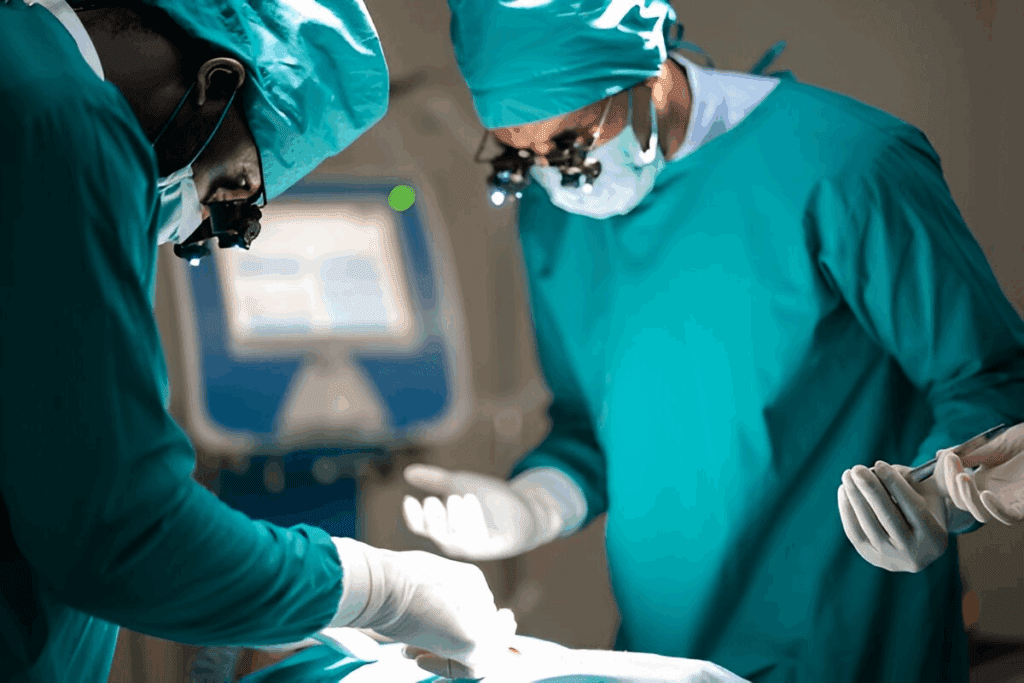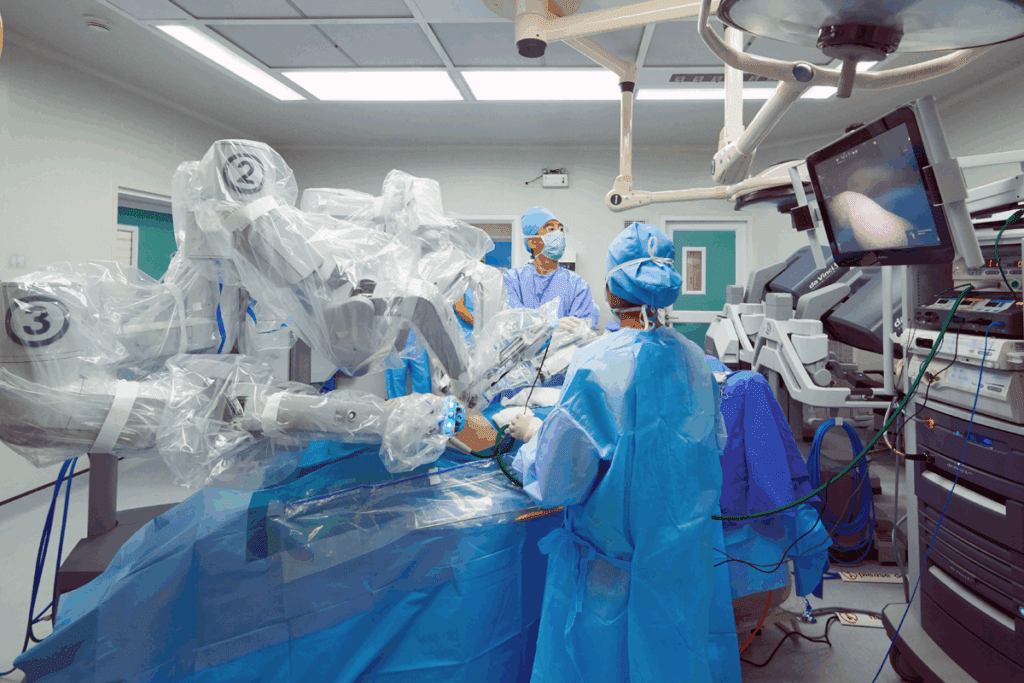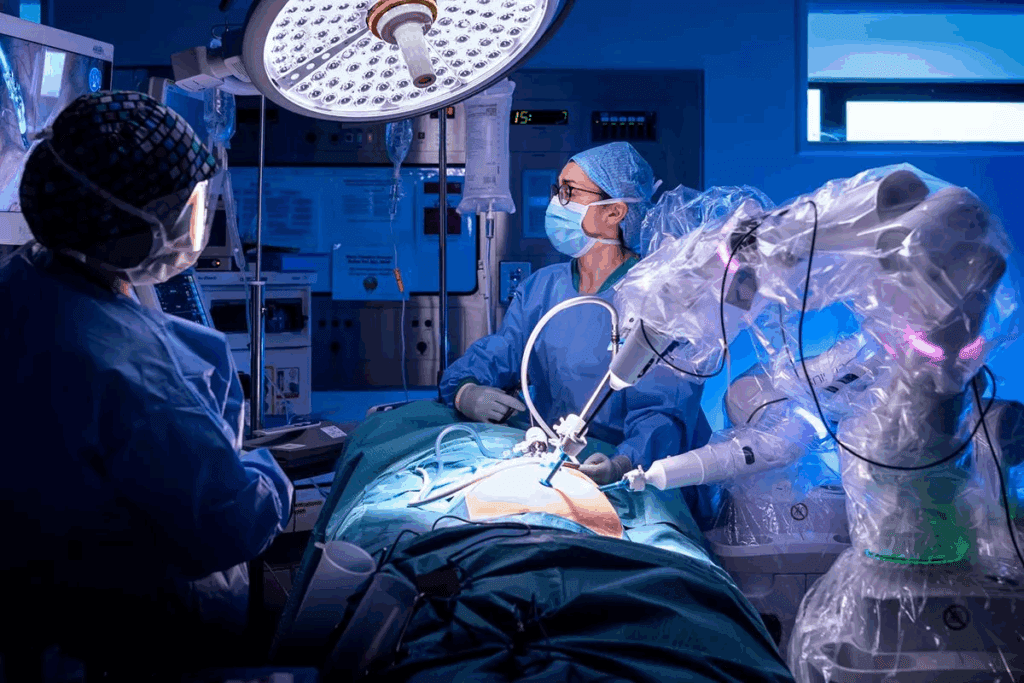Last Updated on November 27, 2025 by Bilal Hasdemir

Recent studies show that robot-assisted heart surgery is getting more popular. This is because of the benefits of advanced surgical technology. These benefits include shorter recovery times and less scarring.
When patients think about this new treatment, they worry about safety. We know it’s important to talk about these worries. We aim to give a full look at the good and bad sides of this new surgery method.

t surgery is a big step forward in heart surgery. It brings better precision and less invasion. This surgery uses several important parts to help surgeons do their job well.
The surgeon’s console is the heart of the robotic surgery system. From here, the surgeon controls the robotic arms with great precision. They use their hands and feet to do so, getting a full view of the surgery.
Key Features of the Surgeon’s Console:
The robotic arms have special tools for heart surgery. These tools can move in many ways, making it easier to work inside the chest.
Robotic heart surgery shines with its 3D view. This clear view helps surgeons do complex repairs better. They can see the heart and its surroundings in great detail.
| Feature | Description | Benefit |
| 3D Visualization | High-definition 3D imaging | Improved precision and accuracy |
| Robotic Arms | Specialized instruments for cardiac procedures | Enhanced dexterity and control |
| Surgeon’s Console | Ergonomic design with precise controls | Reduced surgeon fatigue, improved focus |
Robotic heart surgery combines advanced tech with skilled surgeons. It’s a top choice for treating many heart problems in a less invasive way.

Clinical trials and meta-analyses have looked into robotic heart surgery’s safety. They compare it to traditional surgery. These studies give us important insights into its safety.
Many studies have checked the safety of robotic heart surgery. For example, a study in the Journal of Thoracic and Cardiovascular Surgery found it has fewer complications than traditional surgery.
Key findings from recent studies include:
Robotic heart surgery and traditional open surgery have different safety outcomes. Robotic surgery often means smaller cuts, less damage, and quicker healing.
A comparative study highlighted the following differences:
| Safety Outcome | Robotic Heart Surgery | Traditional Open Surgery |
| Average Hospital Stay | 5 days | 7 days |
| Major Complications Rate | 2% | 5% |
| Infection Rate | 1% | 3% |
A statistical look at complications in robotic heart surgery shows it’s safe. Meta-analyses of many studies found it has fewer complications than traditional surgery.
The data shows robotic heart surgery is a safe and effective choice. It offers big benefits like fewer complications and quicker recovery.
Patients who have robotic heart surgery usually recover faster than those who have open-heart surgery. This is because the surgery uses smaller cuts and causes less damage to tissues.
The time a patient stays in the hospital after robotic heart surgery varies. It depends on how well the patient is doing and how complex the surgery was. Usually, patients stay for a few days.
Managing pain well is key for a smooth recovery. We use different medicines and methods to keep pain low.
Key aspects of pain management include:
Moving early helps patients get stronger and go back to normal activities faster.
How long it takes to get back to normal varies for everyone. Usually, patients can start with light activities in a few weeks.
Rehabilitation programs are very important for recovery. They help patients get stronger and improve their heart health.
These programs are made just for each patient. They might include physical therapy, diet advice, and stress management.
Robotic heart surgery is proving to be a top-notch treatment. Many studies show it’s effective and offers long-term benefits. As more data comes in, its benefits are becoming clearer.
Survival rates after robotic heart surgery are key. Studies show patients do as well as, or better than, those with traditional surgery. For example, a study in the Journal of Thoracic and Cardiovascular Surgery found high survival rates and low complication rates.
Robotic heart surgery greatly improves patients’ quality of life. Smaller cuts and less damage mean less pain and a faster recovery. Most patients see a big boost in their quality of life, getting back to normal in just a few weeks.
The long-term success of robotic heart surgery is also a big plus. Studies show the repairs last a long time, with few needing to be redone. This shows the precision and success of robotic surgery.
Reoperation rates after robotic heart surgery are low. Studies show they’re as good as, or better than, traditional surgery. This low rate shows robotic surgery is reliable and effective.
The success of robotic heart surgery depends a lot on the surgeon’s skills and experience. Just like any advanced medical procedure, how well the surgeon is trained matters a lot for patient results.
Robotic cardiac surgery needs a special set of skills. Surgeons must know how to use traditional surgery techniques and also operate complex robotic systems. They go through tough training programs that cover both theory and practice.
This training includes watching, practicing in a simulated setting, and doing real surgeries under supervision. Simulation training helps surgeons get better in a safe space, lowering the chance of mistakes during real surgeries.
Many studies show that surgeon experience greatly affects results in robotic cardiac surgery. More experienced surgeons have fewer complications, shorter surgeries, and better patient recovery. The volume-outcome relationship is key, as surgeons who do more surgeries get better at it.
The volume-outcome relationship in robotic cardiac surgery shows how important surgeon experience is. High-volume surgeons get better results and help improve the field with their experience and data. It’s vital for patients to ask about their surgeon’s experience and how many robotic surgeries they’ve done.
When thinking about robotic heart surgery, it’s key to know about the surgeon’s training and experience. Choosing a surgeon with a lot of experience in robotic cardiac surgery can greatly improve a patient’s chances of a good outcome.
Heart surgery has changed, giving patients choices. They can pick from robotic, traditional, and minimally invasive methods. It’s important to know how each affects safety, recovery, results, and how happy patients are.
Looking at the safety of these surgeries, we see some key differences. Robotic heart surgery is precise and has fewer risks because it’s less invasive. A study in the Journal of Thoracic and Cardiovascular Surgery showed it has fewer major complications than traditional surgery.
Key safety differences include:
How long it takes to recover is a big deal for heart surgery patients. Robotic surgery is faster because it’s less invasive. A study in the Annals of Thoracic Surgery found robotic patients had shorter stays and got back to normal life sooner than traditional surgery patients.
“Robotic heart surgery has revolutionized the field of cardiac surgery, making it safer and less invasive with quicker recovery times.” – A Cardiac Surgeon
Results after heart surgery can differ based on the method. Robotic surgery is linked to better outcomes, like less sickness and death. A study in the European Journal of Cardio-Thoracic Surgery showed robotic surgery had fewer complications and better survival rates than traditional surgery.
Patient happiness is also important when comparing these surgeries. Robotic surgery often makes patients happier because it causes less pain, leaves smaller scars, and lets them get back to life faster. A survey by the Society of Thoracic Surgeons found robotic surgery patients were more satisfied than those with other methods.
Every patient is different, and the right surgery depends on many things. By looking at these options, we can understand their good and bad points. This helps patients make better choices.
Patient testimonials offer a glimpse into the real effects of robotic heart surgery. They highlight the recovery process and the lasting impact on quality of life. We’ve collected stories from those who’ve had this surgery, showing their journeys and life changes.
Many patients find robotic heart surgery recovery easier than traditional surgery. A patient, 55, said, “I was up and moving in a week, with little pain.”
A patient, 62, noted, “Robotic surgery let me get back to gardening in three weeks. It was faster than I thought.”
Improvements in quality of life are key to measuring robotic heart surgery success. Studies show patients often see big boosts in well-being and physical ability after surgery.
| Aspect | Pre-Surgery | Post-Surgery (6 months) |
| Physical Activity | Limited mobility | Regular exercise |
| Pain Levels | Moderate to severe | Mild or none |
| Energy Levels | Low | Normal or increased |
It’s key to manage patient expectations for a good outcome. Robotic heart surgery has many benefits, but patients need to know what to expect during recovery. We educate our patients thoroughly, preparing them for their journey.
Support groups are essential for recovery, giving patients a community and resources. We encourage our patients to join these groups. It helps them share their experiences and get support from others who’ve gone through similar things.
By sharing patient stories, we aim to give a full picture of robotic heart surgery. This includes the recovery process and the lasting quality of life improvements.
Robotic cardiac surgery is on the verge of a big change. New technology will make surgeries more precise and advanced. This will greatly improve how we treat heart problems.
New robotic systems will have better vision and more control. This means patients will get better care and more complex surgeries can be done.
Key technological advancements include:
Artificial intelligence (AI) is set to change robotic cardiac surgery a lot. AI will help surgeons by analyzing data in real time and predicting problems. It will also help plan surgeries better.
The benefits of AI include:
Robotic cardiac surgery will soon be used for even more complex heart issues. This is thanks to new tech and more skilled surgeons.
Potential areas of expansion include:
Remote robotic cardiac surgery might soon be a reality. Surgeons could operate on patients from anywhere. This could make top-notch heart care available worldwide.
The possibilities of remote surgery include:
When you’re getting ready for a talk with your surgeon about robotic heart surgery, it’s key to ask the right questions. Knowing all about the procedure, its risks, and what recovery will be like is important.
It’s vital to know about the safety of robotic heart surgery. You should talk to your surgeon about possible risks and complications.
Your surgeon’s experience and training are key to a good surgery outcome. It’s important to ask about their background in robotic heart surgery.
Knowing what to expect during recovery helps you prepare. Talk to your surgeon about the typical recovery and long-term results.
It’s also good to talk about other treatment options with your surgeon. Understand the pros and cons of each.
Ask about other surgeries or non-surgical treatments for your condition. Compare robotic heart surgery with these in terms of safety, recovery time, and results.
By asking these questions, you can make a better choice for your treatment. You’ll feel more confident in your decision.
We’ve looked into the safety and success of robotic heart surgery. We’ve covered how it works, patient results, and what’s coming next. The findings show robotic heart surgery is safe and effective for many, with benefits like quicker recovery and better surgery results.
Looking at the evidence, we see robotic heart surgery is safe, backed by studies and patient stories. While all surgeries have risks, the data show it’s a good choice for heart surgery. As technology gets better, we expect even more improvements in robotic heart surgery, leading to better care and results for patients.
Choosing robotic heart surgery should be a decision made with a doctor, considering your personal situation and health history. This way, patients can make smart choices about their care. They can use the newest in cardiac surgery to get the best results.
Robotic heart surgery has many advantages. It uses smaller incisions, leading to less blood loss and fewer complications. This means patients can recover faster.The robotic system also offers better precision and 3D views. This allows for more complex surgeries to be done with high accuracy.
Like any surgery, robotic heart surgery has risks. These include bleeding, infection, and issues with the robotic system. But, studies show these risks are lower than with traditional surgery.
Recovery times vary based on the procedure and the patient. Patients usually spend a few days in the hospital. Then, they recover at home for several weeks.Most people can get back to normal activities within a few weeks.
Robotic heart surgery has a high success rate. It has low complication and mortality rates. Success depends on the surgeon’s skill and the patient’s health.
Robotic heart surgery is a form of minimally invasive surgery. It uses a robotic system for better precision and views. This makes it possible to perform more complex surgeries.
Surgeons need special training for robotic heart surgery. They learn hands-on with the robotic system and in surgical techniques. Their training and experience affect the procedure’s success.
Yes, robotic heart surgery is used for complex procedures. This includes mitral valve repair and coronary artery bypass grafting. The robotic system’s precision and views make these surgeries more accurate.
Robotic heart surgery has excellent long-term results. It has low complication rates and high patient satisfaction. Repair durability and survival rates are often better than traditional surgery.
Subscribe to our e-newsletter to stay informed about the latest innovations in the world of health and exclusive offers!